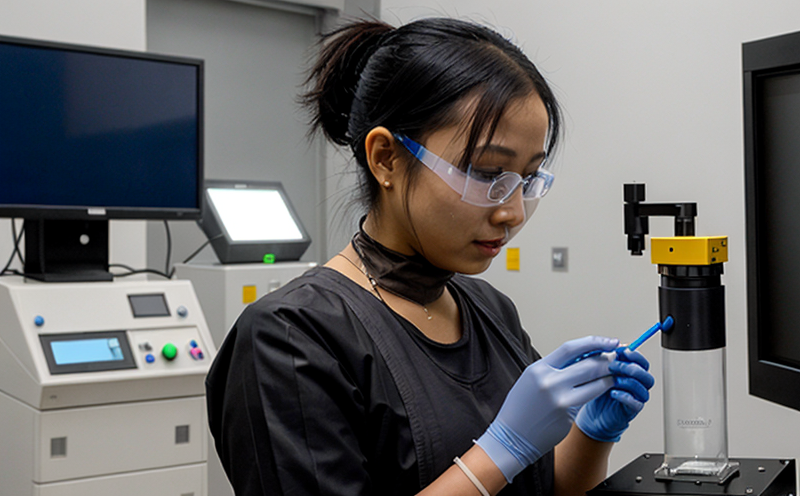ASTM E3247 Chemical Reactivity Testing of Nanoparticles in Aquatic Systems
The ASTM E3247 standard provides a comprehensive framework to assess the chemical reactivity of nanoparticles when introduced into aquatic systems. This service is crucial for ensuring the safe and responsible use of nanomaterials, particularly those intended for environmental applications. The testing protocol focuses on identifying potential environmental risks posed by these materials through controlled laboratory simulations.
Chemical reactivity in this context refers to how nanoparticles may interact with other chemicals present in water bodies, including dissolved organic matter (DOM), pH fluctuations, and various ionic species. Such interactions could lead to the formation of new compounds or exacerbate existing pollutants, thereby posing a threat to aquatic ecosystems.
The ASTM E3247 protocol involves multiple stages designed to simulate real-world conditions as closely as possible. Specimen preparation is critical; nanoparticles are typically dispersed in deionized water and then mixed with a pre-defined DOM solution. The pH of the resulting suspension is adjusted according to environmental conditions relevant to the specific test.
The testing process itself comprises several key steps:
- Initial characterization of the nanoparticle dispersion using techniques like transmission electron microscopy (TEM) and zeta potential measurements.
- Gradual introduction of the nanoparticle solution into an aqueous environment containing DOM under controlled pH conditions.
- Ongoing monitoring of the system over time for any changes in particle size, shape, or concentration due to aggregation or dissolution.
- Analysis of by-products and intermediates formed during the reactivity process using spectroscopic methods (e.g., FTIR) and chromatographic analyses (e.g., HPLC).
The results from these tests help determine whether nanoparticles pose a risk to aquatic organisms or contribute to water quality degradation. Compliance with ASTM E3247 ensures that products meet stringent environmental safety standards, thus protecting both human health and the environment.
| Parameter | Description | Units |
|---|---|---|
| Initial nanoparticle concentration | Starting concentration of nanoparticles in the test suspension. | Mg/L (micrograms per liter) |
| DOM content | Dissolved organic matter present in the aqueous environment. | %w/w (weight percent by weight) |
| pH range of test solution | The pH levels under which the reactivity testing is conducted. | - |
| Temperature | The temperature at which the reactivity tests are performed, simulating environmental conditions. | °C (degrees Celsius) |
| Time intervals for observation | Frequency of sample collection and analysis during the test period. | hours or days |
The ASTM E3247 protocol is widely recognized by regulatory bodies worldwide, making it an essential tool for companies developing nanomaterials with environmental applications. By adhering to this standard, organizations can demonstrate their commitment to sustainability and responsible innovation.
Eurolab Advantages
EuroLab offers unparalleled expertise in ASTM E3247 chemical reactivity testing of nanoparticles in aquatic systems through its state-of-the-art facilities and experienced team. Our dedicated nanotechnology laboratory ensures consistent, accurate results that comply with international standards.
- Advanced Equipment: We utilize cutting-edge analytical instruments such as TEM, SEM, XPS, and UV-Vis spectrophotometers to characterize nanoparticles accurately before testing.
- Comprehensive Expertise: Our team comprises highly skilled chemists, environmental scientists, and engineers who have extensive experience in nanotechnology research and development.
- Customized Solutions: We offer tailored services that cater specifically to your product's unique characteristics and intended application.
- Regulatory Compliance: Our comprehensive testing protocols ensure compliance with all relevant international standards, including ASTM E3247.
By choosing EuroLab for your chemical reactivity testing needs, you gain access to a wealth of knowledge and resources designed to help you navigate the complexities of nanotechnology safely and effectively.
International Acceptance and Recognition
The ASTM E3247 standard has achieved widespread recognition among national standards organizations around the globe. Its acceptance by regulatory authorities in countries like the United States, Canada, Europe, Australia, and New Zealand underscores its importance in ensuring environmental safety.
Several key international bodies have endorsed or referenced ASTM E3247 in their guidelines:
- OECD (Organisation for Economic Co-operation and Development): Recommended for testing nanomaterials in the OECD's Greenhouse Gas Initiative.
- EU REACH: Used to evaluate potential risks associated with nanomaterials under the Registration, Evaluation, Authorisation and Restriction of Chemicals regulation.
- ISO (International Organization for Standardization): Considers ASTM E3247 as a reference standard in its own documentation regarding nanotechnology.
The international acceptance of ASTM E3247 highlights the significance of this testing protocol in shaping global policies on nanomaterials and their environmental impact. Organizations adopting this standard can rest assured that they are adhering to best practices recognized worldwide.
Use Cases and Application Examples
The ASTM E3247 chemical reactivity testing is applicable across a wide range of industries where nanomaterials are used in environmental applications. Here are some specific use cases:
- Water Treatment Technologies: Testing nanoparticles intended for water filtration or purification processes to ensure they do not release harmful compounds into the treated water.
- Coatings and Paints: Assessing nano-coated materials used in paints to determine their stability and potential impact on aquatic ecosystems if released during application.
- Solar Cells: Evaluating the reactivity of nanomaterials incorporated into solar cell designs under varying environmental conditions, including humidity and temperature fluctuations.
The following table provides a more detailed overview of how different nanomaterials have been tested using ASTM E3247 in various applications:
| Nanomaterial Type | Aquatic Environment | Main Testing Focus |
|---|---|---|
| Titanium dioxide (TiO₂) nanoparticles | Photocatalytic water purification systems | Reaction kinetics with organic pollutants like phenols and dyes. |
| Zinc oxide (ZnO) nanoparticles | Solar energy harvesting devices | Photochemical stability and potential for photocorrosion. |
| Silver nanoparticles | Bactericidal coatings for medical instruments | Toxicity assessment on aquatic microorganisms like algae and fish larvae. |
In each application, the ASTM E3247 protocol provides a standardized approach to evaluating nanomaterials' reactivity, ensuring that they are used safely and responsibly in environmental contexts.





